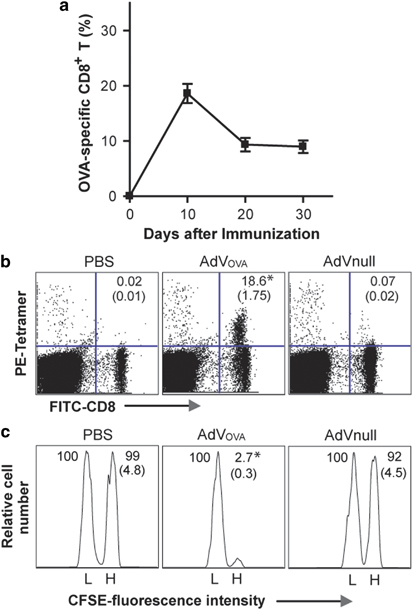Figure 2.

AdVOVA stimulates ovalbumin (OVA)-specific CD8+ cytotoxic T lymphocyte (CTL) responses. (a) The AdVova-immunized C57BL/6 mouse tail blood samples harvested on different days after the immunization of OVA-Texo were stained with PE-H-2Kb/OVAI peptide tetramer and fluorescein isothiocyanate (FITC)-anti-CD8 antibody (Ab), and then analyzed by flow cytometry. (b) The tail blood samples of AdVova-immunized C57BL/6 mice were harvested on day 11 after the immunization and stained with PE-H-2Kb/OVAI peptide tetramer and FITC-anti-CD8 Ab, and then analyzed by flow cytometry. The value in each panel represents the percentage of OVA-specific (tetramer-positive) CD8+ T cells vs the total CD8+ T-cell population. The value in parenthesis represents s.d. (c) In vivo cytotoxicity assay. Six days after the immunization, the immunized mice were i.v. injected with 2 × 106 cells containing a 1:1 mixture of CFSEhigh- and CFSElow-labeled splenocytes that had been pulsed with OVAI or Mut1 peptides, respectively. After 16 h, the spleens of immunized mice were removed and the percentages of the residual CFSEhigh (H) and CFSElow (L) target cells remaining in the recipients’ spleens were analyzed by flow cytometry. The value in each panel represents the percentage of CFSEhigh vs CFSElow target cells remaining in the spleen. The value in parenthesis represents the s.d. *P<0.05 vs cohorts of the control AdVnull group (Student's t-test). One representative experiment of three is shown. AdV, adenovirus; CFSE, carboxyl-fluorescein succinimidyl ester.
